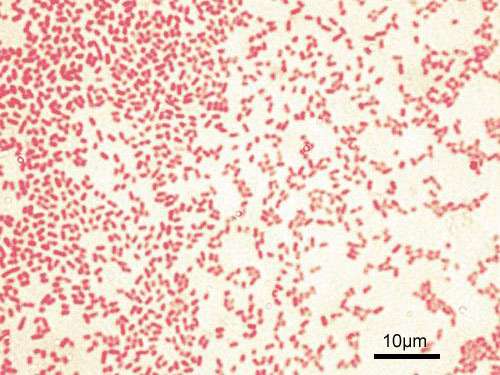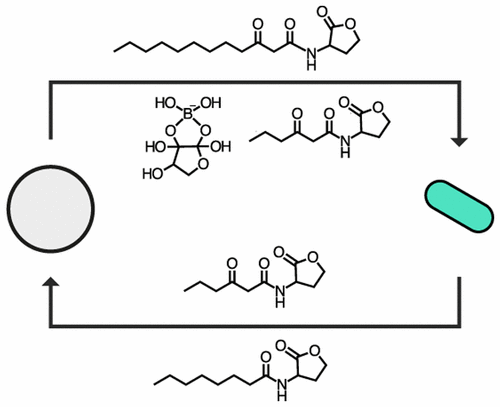Gram-stained P. aeruginosa bacteria (pink-red rods) Credit: Wikipedia
The classic Turing test evaluates a machine's ability to mimic human behavior and intelligence. To pass, a computer must fool the tester into thinking it is human—typically through the use of questions and answers. But single-celled organisms can't communicate with words. So this week in ACS Central Science, researchers demonstrate that certain artificial cells can pass a basic laboratory Turing test by "talking" chemically with living bacterial cells.
Sheref S. Mansy and colleagues proposed that artificial life would need to have the ability to interact seamlessly with real cells, and this could be evaluated in much the same way as a computer's artificial intelligence is assessed.
To demonstrate their concept, the researchers constructed nano-scale lipid vessels capable of "listening" to chemicals that bacteria give off.
The artificial cells showed that they "heard" the natural cells by turning on genes that made them glow. These artificial cells could communicate with a variety of bacterial species, including V. fischeri, E. coli and P. aeruginosa.
The authors note that more work must be done, however, because only one of these species engaged in a full cycle of listening and speaking in which the artificial cells sensed the molecules coming from the bacteria, and the bacteria could perceive the chemical signal sent in return.
Credit: American Chemical Society
More information: Two-Way Chemical Communication between Artificial and Natural Cells, ACS Central Science, pubs.acs.org/doi/full/10.1021/acscentsci.6b00330
Abstract
Artificial cells capable of both sensing and sending chemical messages to bacteria have yet to be built. Here we show that artificial cells that are able to sense and synthesize quorum signaling molecules can chemically communicate with V. fischeri, V. harveyi, E. coli, and P. aeruginosa. Activity was assessed by fluorescence, luminescence, RT-qPCR, and RNA-seq. Two potential applications for this technology were demonstrated. First, the extent to which artificial cells could imitate natural cells was quantified by a type of cellular Turing test. Artificial cells capable of sensing and in response synthesizing and releasing N-3-(oxohexanoyl)homoserine lactone showed a high degree of likeness to natural V. fischeri under specific test conditions. Second, artificial cells that sensed V. fischeri and in response degraded a quorum signaling molecule of P. aeruginosa (N-(3-oxododecanoyl)homoserine lactone) were constructed, laying the foundation for future technologies that control complex networks of natural cells.
Journal information: ACS Central Science
Provided by American Chemical Society

























